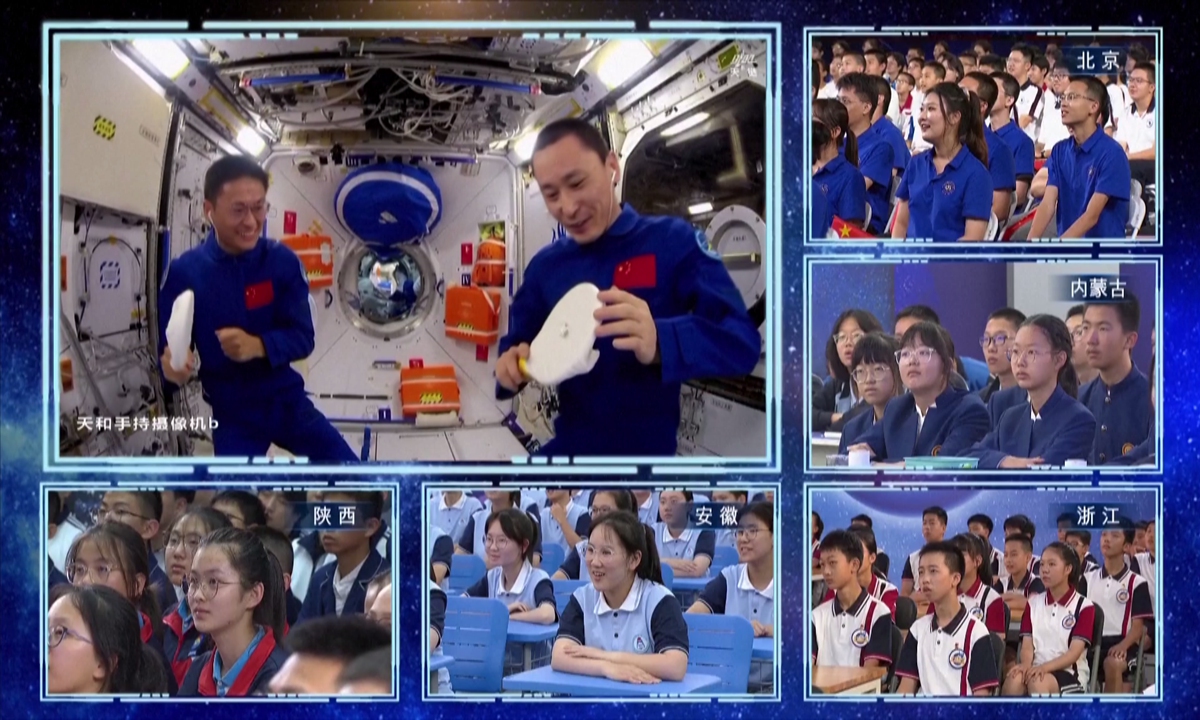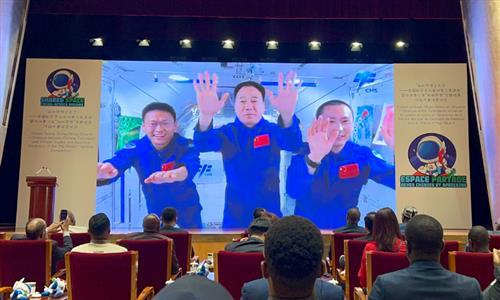Shenzhou-16 crew give 1st space lecture, offering data, hope for future civilian taikonauts

The Shenzhou-16 crew livestreams their first science lecture from China's Tiangong space station on September 21, 2023. Also the first ever given from the Mengtian lab module, the lecture was linked to five classrooms set on the ground with more than 2,400 students and teachers attending. Photo: VCG
A round candle flame, a water ping pong ball… The Shenzhou-16 crew on Thursday livestreamed their first science lecture from China's Tiangong space station, also the first ever given from the Mengtian lab module. Different from previous lectures that were mostly focused on popularizing science, the new episode provides practical and valuable experimental data for researchers in the field and serves as an inspiration for more scientists to become payload specialists that could one day fly to space themselves in the future.
Five classrooms were set on the ground with more than 2,400 students and teachers attending, including one at Beihang University in Beijing - the school where Shenzhou-16 crew member Gui Haichao, the country's first civilian taikonaut, teaches. Students from Beihang University's School of Astronautics sat in the front rows, intently listening to yet another lecture given by their mentor - only this time, it was not face-to-face but space-to-ground.
The Shenzhou-16 crew first took the audience of a tour of the various experimental cabins inside the Mengtian lab module, and conducted experiments to showcase how the space environment changes the common phenomena people observe on the ground. For example, in a ping pong gaming experiment, a ball made from water stuck firmly to a regular racket while it bounced off when hit by a racket wrapped in a towel.
Apart from such science popularization experiments, the crew also conducted a gyroscope experiment and another on the conservation of angular momentum. "The inclusion of these experiments has taken into consideration of college students. For senior undergraduate and even graduate students majoring in spacecraft design at our university, it is necessary to study and apply these set of principles presented on the space station to solve actual problems," Zhang Xiaotian, an associate professor at Beihang University's School of Astronautics and colleague of Gui's, told the Global Times.
Gui's inclusion has also brought new vitality and meaning to the Tiangong Classroom series, Zhang said, noting that he had had a few brief conversations with Gui prior to the space lecture and, "seeing him in such an energetic state on the space station, just like the way he was in school, brought us immense joy and confidence."
Li Jingxuan, a professor from the School of Astronautics at Beihang University and another of Gui's colleagues, told the Global Times that his research focuses on engine combustion. Gravity has a significant impact on flames, especially diffusion flames, and the stability of flames differs greatly between ground and weightless conditions.
Therefore, this space lecture focused on flame experiments under ideal weightless conditions, providing valuable environment and experimental data for research in engine combustion, Li said.
The space lecture once again reminded people of the importance of developing space technology, which can yield significant output with relatively low costs, and even bring about leapfrog development for various industries, Song Zhongping, a space analyst and TV commentator, told the Global Times on Thursday. It helps dispel the misconception that space exploration is a "waste of money," he noted.
What's more, the new episode featuring the inclusion of a civilian taikonaut is sure to serve as an inspiration for more payload scientists to venture into space one day, as well as encourage youths to develop an interest in and devote themselves to cutting-edge technology, experts noted.
A few days prior to the lecture, the Shenzhou-16 crew staged the space station's first art exhibition of paintings drawn by African youths. Taking the launch of these youths' dreams into space as a starting point, the potential for China-Africa space cooperation will be "as broad as the starry sea," said mission commander Jing Haipeng as he introduced the paintings some 400 kilometers above Earth.


